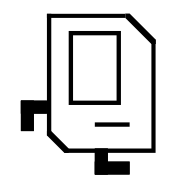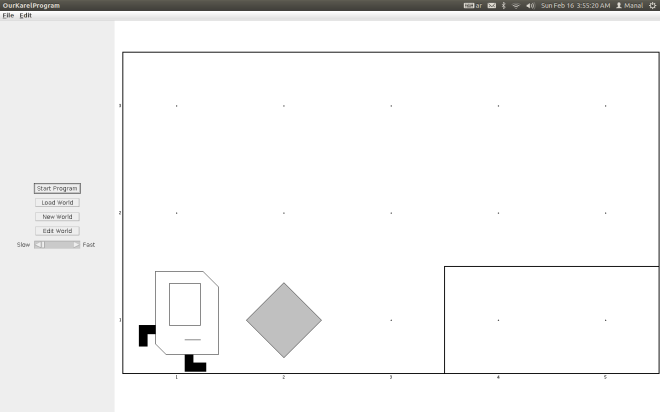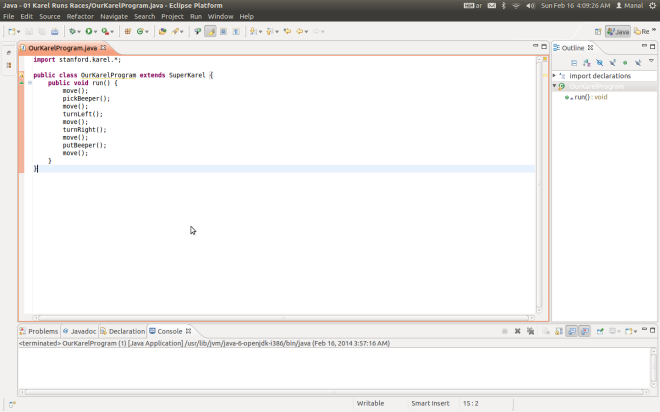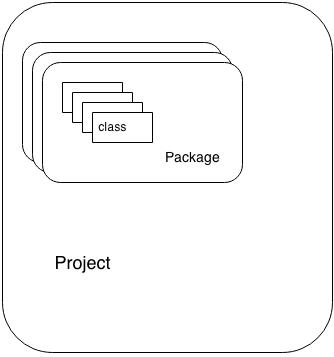As always, a function is a module of code that takes information in (referring to that information with local symbolic names called parameters), does some computation, and (usually) returns a new piece of information based on the parameter information.
A Function Prototype
In C, all functions must be written to return a specific TYPE of information and to take in specific types of data (parameters). This information is communicated to the compiler via a function prototype.
Here is the syntax for the function declaration or Prototype:
RETURN_TYPE name_of_function ( PARAMETER_TYPE name_of_param,PARAMETER_TYPE name_of_param, etc);
// here are some examples of prototypes used at the top of a file:
float sqrt( float x );
float average( int grades[], int length );
A Prototype can occur at the top of a C source code file to describe what the function returns and what it takes (return type and parameter list). When this is the case (occuring at the top of the file), the function prototype should be followed by a semi-colon
The function prototype is also used at the beginning of the code for the function. Thus the prototype can occur twice in a C source code file. When the prototype occurs with the code NO semicolon is used.
The Main Function
In C, the "main" function is treated the same as every function, it has a return type (and in some cases accepts inputs via parameters). The only difference is that the main function is "called" by the operating system when the user runs the program. Thus the main function is always the first code executed when a program starts.
int // the main function will usually returns a 0 if successful
main() // this is the name, in this case: main
{
// this is the body of the function (lots of code can go here)
}
Examples of C Functions:
double // this is the return type
max( double param1, double param2) // this is the name, followed by the parameters
{
if (param1 > param2)
{
return param1; // Notice: that param1 is of type double and the return
// type is also of type double
}
else
{
return param2;
}
}
void // This is the return type (void means no value is computed and returned by the function!)
print_happy_birthday( int age )
{
printf("Congratulations on your %d th Birthday\n", age);
return; // you can "terminate" a void function by using return.
// HERE it is REDUNDANT because the function is over anyway.
}
Return Type of a C function
Every C function must specify the type of data that is being generated. For example, the max function above returns a value of type "double". Inside the function, the line "return X;" must be found, where X is a value or variable containing a value of the given type.
The return statement
When a line of code in a function that says: "return X;" is executed, the function "ends" and no more code in the function is executed. The value of X (or the value in the variable represented by X) becomes the result of the function.
Calling a C function (aka invoke a function)
When one piece of code invokes or calls a function, it is done by the following syntax:
variable = function_name ( args, ...);
The function name must match exactly the name of the function in the function prototype. The args are a list of values (or variables containing values) that are "passed" into the function.
The number of args "passed" into a function
must exactly match the number of parameters required for the function. The type of each arg
must exactly match the type of each parameter. The return variable type
must exactly match the return type of the function.
The "variable" in the example above must have a type equivalent to the return type of the function. Inside the function, somewhere will be the line "return X". The value of X is then copied into the "variable".
Parameters in C functions
A Parameter is the symbolic name for "data" that goes into a function. There are two types of parameters in C: Pass by Value, Pass by Reference.
Pass by Value
Pass by Value, means that a copy of the data is made and stored by way of the name of the parameter. Any changes to the parameter have NO affect on data in the calling function.
Pass by Reference
A reference parameter "refers" to the original data in the calling function. Thus any changes made to the parameter are ALSO MADE TO THE ORIGINAL variable.
There are two ways to make a pass by reference parameter:
- ARRAYS
Arrays are always pass by reference in C. Any change made to the parameter containing the array will change the value of the original array.
- The ampersand used in the function prototype.
function ( & parameter_name )
To make a normal parameter into a pass by reference parameter, we use the "& param" notation. The ampersand (&) is the syntax to tell C that any changes made to the parameter also modify the original variable containing the data.
Pass by Value Example:
In C, the default is to pass by value. For example:
//
// C function using pass by value. (Notice no &)
//
void
doit( int x )
{
x = 5;
}
//
// Test function for passing by value (i.e., making a copy)
//
int
main()
{
int z = 27;
doit( z );
fprintf('z is now %d\n', z);
return 0;
}
Pass by Reference Example:
Again, remember the Syntax is to use the '&' in front of the variable. For example:
//
// C using Reference Parameter!
//
void
doit( int & x )
{
x = 5;
}
//
// Test code for passing by a variable by reference
//
int
main()
{
int z = 27;
doit( z );
fprintf('z is now %d\n', z);
return 0;
}
In summary, if you use a reference parameter, any changes to the parameter inside the function are reflected "outside" of the function! If you don't use the & (pass by reference), then we get the same behavior as in Matlab.
Reference parameters are used to make programs more "efficient". Consider passing in a structure as a parameter. If the structure is very big, and we copy all of it, then we are using a lot of unnecessary memory.
Array Parameter Example (ALWAYS pass by reference)
Arrays are always
passed by reference in C. They
do not use the '&' notation, but are pass by reference none the less. For example:
//
// Initialize an array with values 1,2,3,...,length_of_array
//
// Notice: Any changes made to "array_variable" are reflected in
// the calling code! Arrays are pass by reference!
//
// Notice: There is no return statement, but still the array is changed
// and can be said to be "returned" to the calling function.
//
void
build_array( int array_variable[], int length_of_array )
{
for (int i=0; i<length_of_array; i++)
{
array_variable[i] = i;
}
}
//
// Test code for passing an array by reference
//
int
main()
{
int values[50];
fprintf('the value at location 7 starts as %d\n', values[7]);
build_array(values, 50);
fprintf('the value at location 7 is now %d\n', values[7]);
return 0;
}
Constant Reference
To protect from accidentally changing a reference parameter, when we really want it not to be changed (we just want to save time/memory) we can use the C keyword
const. For example:
//
// C Code using a CONSTANT reference Parameter
//
void
doit( const int & x )
{
x = 5; // ILLEGAL
}
//
// Main Function
//
int
main()
{
int z = 27;
doit( z );
fprintf('z is now %d\n', z);
return 0;
}
Void Functions
If a function does not return a value, then a special "TYPE" is used to tell the computer this. The return type is "void" (all lower case).
Void functions are mostly used in two classes of functions.
- The first is a function that prints information for the user to read. For example (for our purposes), the printf function is treated as a void function. (In actuality, printf returns an integer which is the number of characters printed... but we almost always ignore this value.)
- The second use of void functions is with "reference" parameters (e.g., Arrays). A reference parameter is not a copy of the input data, as is so often the case. A reference parameter is an "alias" for the same bucket in memory as the input data. Thus any change made to a reference parameter is in fact made to the original variable!







